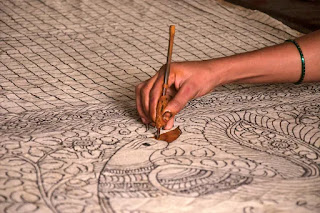The History, Creation and Process of Kalamkari
Hello, my Four Sides TV Fashion Fam!
"Kalamkari" originates from the Persian words "Kalam," which means pen, and "Kari," which means artistic endeavor, as well as the Urdu term "Qalam." With this type of art, handloom fabric is dyed naturally using a twig fashioned like a pen. Within the districts of Chittoor and Krishna, namely Srikalahasti and Machilipatnam, artists from many communities engage in this art form.
The Indus Valley Civilization is where Kalamkari's origins can be found, as evidenced by the discovery of painted or printed textiles in the eighth century C.E. During the Mughal era, art flourished and products such as prayer mats and kanat, or tent covers, were produced. Golconda, Chennai, and Machilipatnam served as the center of this art form, with artistic creations in Golconda that catered to Persian preferences and directly supported Srikalahasti temples.
From the fifteenth or sixteenth century, bed linens, garments, and other products made of kalamkari fabric were exported to Europe and Iran. In the 19th century, block printing took the place of pens.
One characteristic that sets Kalamkari apart is the artist's use of vegetable colors derived from natural sources such as fruits, roots, leaves, and flowers. In Srikalahasti, pens made of bamboo sticks with felt wrapped around them are used to paint directly into the cloth. Pencil-sharp lines are printed on textile surfaces at Machilipatnam by being transferred onto wooden blocks. The cloth is made with block makers, washers, and printers all working under one roof.
Machilipatnam style:
Srikalahasthi style:
A primary source of influence for the Srikalahasti style was temples. Under the temples' influence, the art flourished as a result of their need for scrolls and wall hangings that included narrative and figurative elements. With a script running along the border, it depicted scenes from the Ramayana, Mahabharata, Puranas, and other mythological stories in rich detail. Only gods like Krishna, Brahma, Ganesha, the Durga, Lakshmi, Rama, Shiva, and Parvathi could be painted.
Process of making:
Hand printing and resist-dying are two time-consuming, difficult steps in the painting process used in Kalamkari art. Many steps must be taken before the desired outcomes are realized. In contrast to other painting techniques, Kalamkari painting on cotton fabric requires extensive care both before and after the painting is finished. The colors alter by the way the fabric is treated or the calibre of the mordant used. Each process is carried out precisely and meticulously, starting with soaking the cloth and ending with washing and drying it. People are avoiding hazardous chemical colors all throughout the world. The textiles that are organically dyed and safe to use are used for painting Kalamkari. The painters support the use of natural dyes made from flowers, roots, and bark.
Stay connected and Stay healthy!
Thank you,
Four Sides TV Fashion.



.webp)




Comments
Post a Comment